Relationship between Flexible Work Arrangements and Employees Job Satisfaction through Work-Family Enrichment
This study aims to explore the relationship between flexibility working arrangement and job satisfaction, with a focus on the mediating role of work-family enrichment and work-family conflict. The introduction, literature review, and research methodology are discussed in this document.
51 Pages13679 Words93 Views
Added on 2023-06-11
About This Document
This study examines the impact of flexible work arrangements on employees' job satisfaction through the mediating role of work-family enrichment. It explores the relationship between flexplace and flextime on job satisfaction and the mediating role of work-family enrichment. The study is conducted on office workers in Bandar Sunway, Malaysia.
Relationship between Flexible Work Arrangements and Employees Job Satisfaction through Work-Family Enrichment
This study aims to explore the relationship between flexibility working arrangement and job satisfaction, with a focus on the mediating role of work-family enrichment and work-family conflict. The introduction, literature review, and research methodology are discussed in this document.
Added on 2023-06-11
ShareRelated Documents
The Relationship between Flexible Work Arrangements and Employees Job Satisfaction
through the Mediating Role of Work-Family Enrichment
Name
Institution
through the Mediating Role of Work-Family Enrichment
Name
Institution
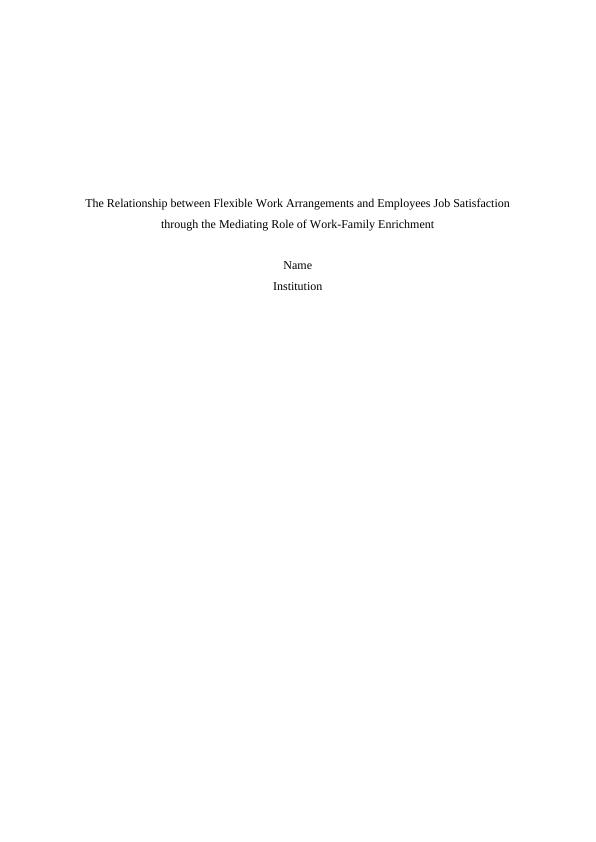
The Relationship between Flexible Work Arrangements and Employees Job Satisfaction
through the Mediating Role of Work-Family Enrichment
Contents
LIST OF TABLES...................................................................................................................4
LIST OF FIGURES.................................................................................................................4
CHAPTER 1.............................................................................................................................1
1.0 Introduction...................................................................................................................1
1.1 Background.....................................................................................................................1
1.2 Problem Statement.........................................................................................................2
1.3 Significance of Study......................................................................................................3
1.4 Research Question..........................................................................................................3
1.5 General Objectives.........................................................................................................3
1.5.1 Specific Objectives..................................................................................................4
1.6 Research Hypothesis......................................................................................................4
1.7 Research Scope...............................................................................................................6
CHAPTER 2:............................................................................................................................6
LITERATURE REVIEW........................................................................................................6
2.0 Introduction........................................................................................................................6
2.1 Flexible Work Arrangements.......................................................................................7
2.1 Types of Flexible Work Arrangements........................................................................8
2.2 Conception of Employees’ Job Satisfaction...............................................................11
2.2 Flexibility Working Arrangement and Employees Satisfaction..............................12
2.3 Mediating Variable......................................................................................................13
2.3.1 Work-Family Enrichment........................................................................................13
2.4 Theoretical Framework...............................................................................................14
CHAPTER 3:..........................................................................................................................15
RESEARCH METHODOLOGY.........................................................................................15
3.0 Introduction......................................................................................................................15
3.1 Research Design...........................................................................................................15
3.2 Research Strategy........................................................................................................15
3.3 Sampling and Data Collection....................................................................................16
3.3.1 Sampling Technique.................................................................................................16
3.3.2 Data Collection..........................................................................................................16
3.4 Questionnaire Design and Content.............................................................................17
3.5 Pilot Study.....................................................................................................................17
3.6 Internal and External Validity....................................................................................18
2
through the Mediating Role of Work-Family Enrichment
Contents
LIST OF TABLES...................................................................................................................4
LIST OF FIGURES.................................................................................................................4
CHAPTER 1.............................................................................................................................1
1.0 Introduction...................................................................................................................1
1.1 Background.....................................................................................................................1
1.2 Problem Statement.........................................................................................................2
1.3 Significance of Study......................................................................................................3
1.4 Research Question..........................................................................................................3
1.5 General Objectives.........................................................................................................3
1.5.1 Specific Objectives..................................................................................................4
1.6 Research Hypothesis......................................................................................................4
1.7 Research Scope...............................................................................................................6
CHAPTER 2:............................................................................................................................6
LITERATURE REVIEW........................................................................................................6
2.0 Introduction........................................................................................................................6
2.1 Flexible Work Arrangements.......................................................................................7
2.1 Types of Flexible Work Arrangements........................................................................8
2.2 Conception of Employees’ Job Satisfaction...............................................................11
2.2 Flexibility Working Arrangement and Employees Satisfaction..............................12
2.3 Mediating Variable......................................................................................................13
2.3.1 Work-Family Enrichment........................................................................................13
2.4 Theoretical Framework...............................................................................................14
CHAPTER 3:..........................................................................................................................15
RESEARCH METHODOLOGY.........................................................................................15
3.0 Introduction......................................................................................................................15
3.1 Research Design...........................................................................................................15
3.2 Research Strategy........................................................................................................15
3.3 Sampling and Data Collection....................................................................................16
3.3.1 Sampling Technique.................................................................................................16
3.3.2 Data Collection..........................................................................................................16
3.4 Questionnaire Design and Content.............................................................................17
3.5 Pilot Study.....................................................................................................................17
3.6 Internal and External Validity....................................................................................18
2

3.6 Ethical Considerations of the Research.....................................................................18
3.5 Data Analysis................................................................................................................19
CHAPTER 4:..........................................................................................................................20
EMPIRICAL RESULTS.......................................................................................................20
4.1 Study’s Demographic Statistics..............................................................................20
4.2 Hypotheses Testing..................................................................................................25
4.3 Hierarchical Multiple Regression Analysis...............................................................26
CHAPTER 5...........................................................................................................................30
DISCUSSION AND CONCLUSIONS.................................................................................30
5.1 Discussion of the Empirical Results...........................................................................30
5.2 Empirical Research Findings......................................................................................30
5.3 Testing the mediation...................................................................................................34
CHAPTER 6...........................................................................................................................35
RESEARCH LIMITATIONS...............................................................................................35
CHAPTER 7...........................................................................................................................36
CONCLUSION.......................................................................................................................36
REFERENCES.......................................................................................................................38
APPENDIX.............................................................................................................................42
Appendix A: Introduction to the Questionnaire.............................................................42
Appendix B: Questionnaire...............................................................................................43
3
3.5 Data Analysis................................................................................................................19
CHAPTER 4:..........................................................................................................................20
EMPIRICAL RESULTS.......................................................................................................20
4.1 Study’s Demographic Statistics..............................................................................20
4.2 Hypotheses Testing..................................................................................................25
4.3 Hierarchical Multiple Regression Analysis...............................................................26
CHAPTER 5...........................................................................................................................30
DISCUSSION AND CONCLUSIONS.................................................................................30
5.1 Discussion of the Empirical Results...........................................................................30
5.2 Empirical Research Findings......................................................................................30
5.3 Testing the mediation...................................................................................................34
CHAPTER 6...........................................................................................................................35
RESEARCH LIMITATIONS...............................................................................................35
CHAPTER 7...........................................................................................................................36
CONCLUSION.......................................................................................................................36
REFERENCES.......................................................................................................................38
APPENDIX.............................................................................................................................42
Appendix A: Introduction to the Questionnaire.............................................................42
Appendix B: Questionnaire...............................................................................................43
3
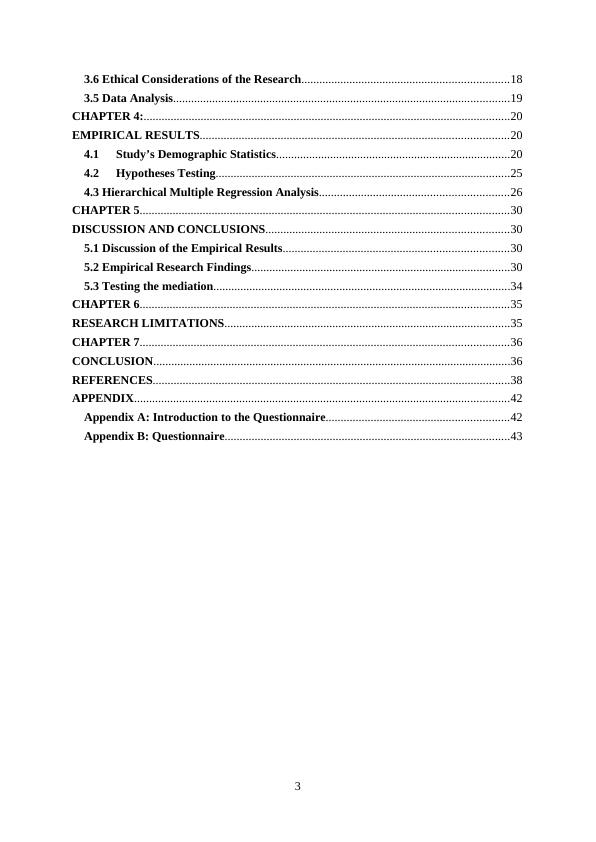
LIST OF TABLES
Table 1: Hypotheses Texting and the Employed Analytical Methods.....................................25
Table 2: Statistics for regression for model 1..........................................................................27
Table 3: Regression coefficients for model 1a.........................................................................28
Table 4: Statistics for regression model 2................................................................................28
LIST OF FIGURES
Figure 1: Distribution of the respondents in relation to gender...............................................21
Figure 2: Distribution of the respondents in relation to age....................................................22
Figure 3: Distribution of the respondents in relation to their education level.........................23
Figure 4: Distribution of the respondents in relation to the marital status...............................23
Figure 5: Distribution of the respondents in relation to years of service.................................24
Figure 6: Distribution of the respondents in relation to ethnicity............................................24
4
Table 1: Hypotheses Texting and the Employed Analytical Methods.....................................25
Table 2: Statistics for regression for model 1..........................................................................27
Table 3: Regression coefficients for model 1a.........................................................................28
Table 4: Statistics for regression model 2................................................................................28
LIST OF FIGURES
Figure 1: Distribution of the respondents in relation to gender...............................................21
Figure 2: Distribution of the respondents in relation to age....................................................22
Figure 3: Distribution of the respondents in relation to their education level.........................23
Figure 4: Distribution of the respondents in relation to the marital status...............................23
Figure 5: Distribution of the respondents in relation to years of service.................................24
Figure 6: Distribution of the respondents in relation to ethnicity............................................24
4
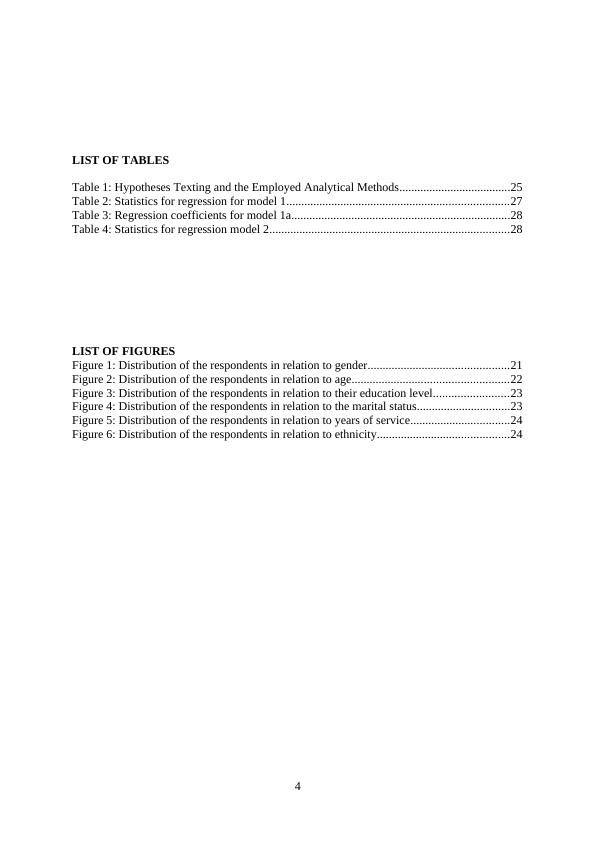
Running Head: FLEXIBLE WORK ARRANGEMENTS AND JOB SATISFACTION 1
CHAPTER 1
1.0 Introduction
Job satisfaction impacts both on the employer and employees, these impacts include work-
family engagements, career success, engagement, turnover rates, absenteeism, and the quality
of work. Adopting work flexibility arrangements at the places of works has been attributed
with improving job satisfaction (Thomas, 2014). In this study, the investigator builds on
existing literature and theories as he seeks to establish the relationships that is extant between
work flexibility arrangements and employees jobs satisfaction. This section details the
background of research, problem statement, and research question and research objectives. .
1.1 Background
The manners in which flexible working arrangements impacts works, and the subsequent
impacts on the bottom line, are of paramount interest to companies especially in gaining
competitive advantages amid increasing globalization activities. Notwithstanding, many
organizations are left to resolve if and how they will offer flexibility, and conclusions are
mostly based on how they observe such arrangements will impact their capacity to be
receptive to business needs. Flexibility in the places of works serves as a useful and critical
resource for workers, permitting them to control the duration, timing, and setting of carrying
out their job (Carlson, Grzywacz, & Michele Kacmar, 2010). Such arrangements are
repeatedly offered in hopes of enticing and retaining top talent through increasing employees,
work-life balance, job satisfaction, and organizational commitment (Albrecht, 2012). On top
of providing flexible work arrangements as a family-friendly advantage, scholars and public
activists have also called for organizations to provide flexible work arrangements in to help
promote employee well-being and health (Thomas, 2014 ) and to assist in addressing the
growing need of organizations to increase employees productivity occasioned by increased
level of satisfaction. Flexibility may materialize in the form of varying work locations or
CHAPTER 1
1.0 Introduction
Job satisfaction impacts both on the employer and employees, these impacts include work-
family engagements, career success, engagement, turnover rates, absenteeism, and the quality
of work. Adopting work flexibility arrangements at the places of works has been attributed
with improving job satisfaction (Thomas, 2014). In this study, the investigator builds on
existing literature and theories as he seeks to establish the relationships that is extant between
work flexibility arrangements and employees jobs satisfaction. This section details the
background of research, problem statement, and research question and research objectives. .
1.1 Background
The manners in which flexible working arrangements impacts works, and the subsequent
impacts on the bottom line, are of paramount interest to companies especially in gaining
competitive advantages amid increasing globalization activities. Notwithstanding, many
organizations are left to resolve if and how they will offer flexibility, and conclusions are
mostly based on how they observe such arrangements will impact their capacity to be
receptive to business needs. Flexibility in the places of works serves as a useful and critical
resource for workers, permitting them to control the duration, timing, and setting of carrying
out their job (Carlson, Grzywacz, & Michele Kacmar, 2010). Such arrangements are
repeatedly offered in hopes of enticing and retaining top talent through increasing employees,
work-life balance, job satisfaction, and organizational commitment (Albrecht, 2012). On top
of providing flexible work arrangements as a family-friendly advantage, scholars and public
activists have also called for organizations to provide flexible work arrangements in to help
promote employee well-being and health (Thomas, 2014 ) and to assist in addressing the
growing need of organizations to increase employees productivity occasioned by increased
level of satisfaction. Flexibility may materialize in the form of varying work locations or
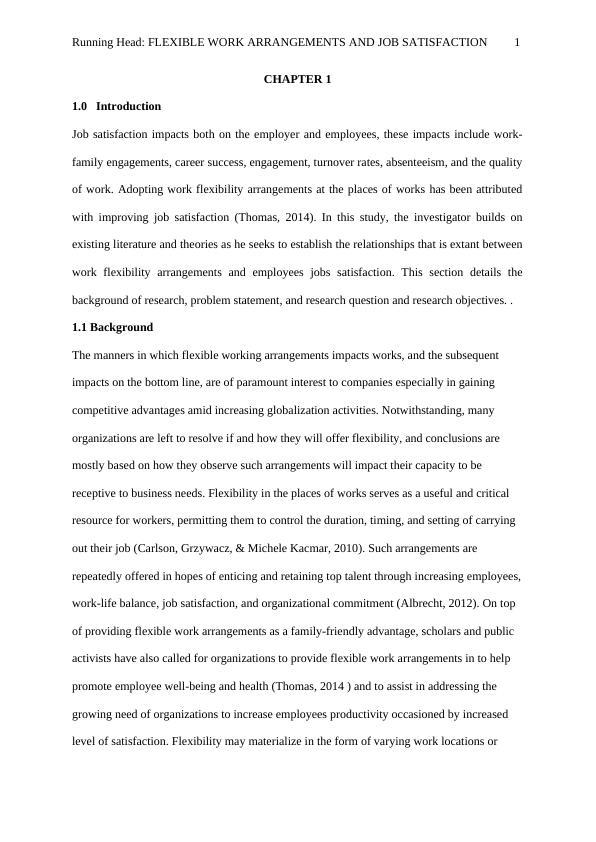
FLEXIBLE WORK ARRANGEMENTS AND JOB SATISFACTION 2
work hours and can transpire both through formal agreements and policies or more informal
understandings. FWA in relation to scheduling denotes altering the temporal constituents of
the work and may be signified through compressed workweeks (i.e., working for more hours
over fewer days) or flextime (i.e., setting start and end periods). On the other hand location
flexibility, is described by Snyder (2016), as the autonomy in deciding the physical setting of
where a worker finishes their tasks and is commonly characterized by remote work or
telecommuting (e.g., working from home or other sites other than the central office)
(Pettorelli, Else, & Sumner, 2012). In this current work, the researcher builds on extant
literature and intends to offer richer insights into the relationship between FWA and
employees’ job satisfaction.
1.2 Problem Statement
The alarming pace of economic developments in the 21st century across the world has
fashioned new activities for the almost all organizations. Globalization has transformed the
planet into a global village and has subsequently pushed the organizations from all sectors to
strive hard to acquire and sustain their competitive advantage. These societal trends and
changes have made work flexibility a subject of interest for scholars and practitioners
examining its impacts on the employee, work and family. Although many scholars have tied
work flexibility to a throng of vital organizational and employees results for example
improved employees health and increased employees satisfaction, much less is recognized
about the relationship between flexible work arrangements and employees job satisfaction,
and the extant body of research has been acknowledged as underdeveloped, both empirically
and conceptually (Jung Jang, Zippay, & Park, 2012). It has been hypothesized that flexibility
at work can stimulate employees’ satisfaction and well-being by allowing them to better
balance work activities and other life demands (Lambert, Haley-Lock, & Henly, 2012).
Nonetheless, the body of research as it stands is incomplete and is comprised of inconsistent
2
work hours and can transpire both through formal agreements and policies or more informal
understandings. FWA in relation to scheduling denotes altering the temporal constituents of
the work and may be signified through compressed workweeks (i.e., working for more hours
over fewer days) or flextime (i.e., setting start and end periods). On the other hand location
flexibility, is described by Snyder (2016), as the autonomy in deciding the physical setting of
where a worker finishes their tasks and is commonly characterized by remote work or
telecommuting (e.g., working from home or other sites other than the central office)
(Pettorelli, Else, & Sumner, 2012). In this current work, the researcher builds on extant
literature and intends to offer richer insights into the relationship between FWA and
employees’ job satisfaction.
1.2 Problem Statement
The alarming pace of economic developments in the 21st century across the world has
fashioned new activities for the almost all organizations. Globalization has transformed the
planet into a global village and has subsequently pushed the organizations from all sectors to
strive hard to acquire and sustain their competitive advantage. These societal trends and
changes have made work flexibility a subject of interest for scholars and practitioners
examining its impacts on the employee, work and family. Although many scholars have tied
work flexibility to a throng of vital organizational and employees results for example
improved employees health and increased employees satisfaction, much less is recognized
about the relationship between flexible work arrangements and employees job satisfaction,
and the extant body of research has been acknowledged as underdeveloped, both empirically
and conceptually (Jung Jang, Zippay, & Park, 2012). It has been hypothesized that flexibility
at work can stimulate employees’ satisfaction and well-being by allowing them to better
balance work activities and other life demands (Lambert, Haley-Lock, & Henly, 2012).
Nonetheless, the body of research as it stands is incomplete and is comprised of inconsistent
2
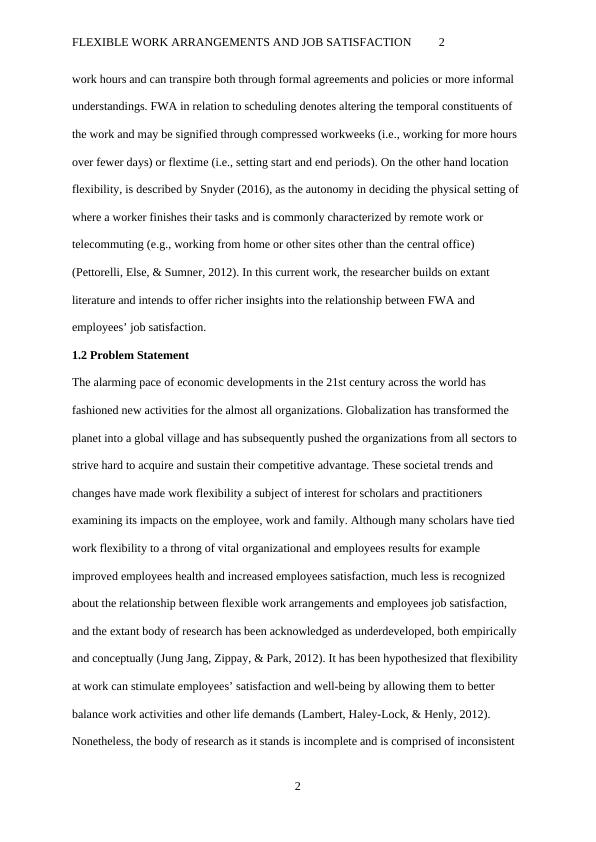
FLEXIBLE WORK ARRANGEMENTS AND JOB SATISFACTION 3
or unclear findings which call for future investigations that may offer richer insights. In the
present study, the investigator builds on previous literature and intends to deliberate richer
insights on the relationship between flexible work arrangements and employees job
satisfaction.
1.3 Significance of Study
As the quest for companies to get benefits from FWA and to increase employees satisfaction
and wellness increases and continues, there is a dire need to produce investigation that
contributes to a knowledge base that can be employed to help guide and inform organizations
in how to best design FWA for employees, and presents justification and documentation for
doing so. In this regard, this study aims to expand the existing knowledge on FWA and their
effects on employees’ satisfaction and organizational commitment. Besides, this research will
examine the mediating role of work-family enhancement; i.e., if work-family improvement
mediates between FWA and on employees job satisfaction to enhance the relationships of
flexibility and positive employees attitude.
1.4 Research Question
This study will be guided by the following research questions;
1. To what extent does flexible work arrangements affect the satisfaction rates of the
employees and their performances as well?
2. Does family play a role in mediating the relationship between FWA and employees
job satisfaction?
1.5 General Objectives
This study aims to examine the Relationship between the FWA and employees’ job
satisfaction through the mediating role or work-family enrichment
3
or unclear findings which call for future investigations that may offer richer insights. In the
present study, the investigator builds on previous literature and intends to deliberate richer
insights on the relationship between flexible work arrangements and employees job
satisfaction.
1.3 Significance of Study
As the quest for companies to get benefits from FWA and to increase employees satisfaction
and wellness increases and continues, there is a dire need to produce investigation that
contributes to a knowledge base that can be employed to help guide and inform organizations
in how to best design FWA for employees, and presents justification and documentation for
doing so. In this regard, this study aims to expand the existing knowledge on FWA and their
effects on employees’ satisfaction and organizational commitment. Besides, this research will
examine the mediating role of work-family enhancement; i.e., if work-family improvement
mediates between FWA and on employees job satisfaction to enhance the relationships of
flexibility and positive employees attitude.
1.4 Research Question
This study will be guided by the following research questions;
1. To what extent does flexible work arrangements affect the satisfaction rates of the
employees and their performances as well?
2. Does family play a role in mediating the relationship between FWA and employees
job satisfaction?
1.5 General Objectives
This study aims to examine the Relationship between the FWA and employees’ job
satisfaction through the mediating role or work-family enrichment
3
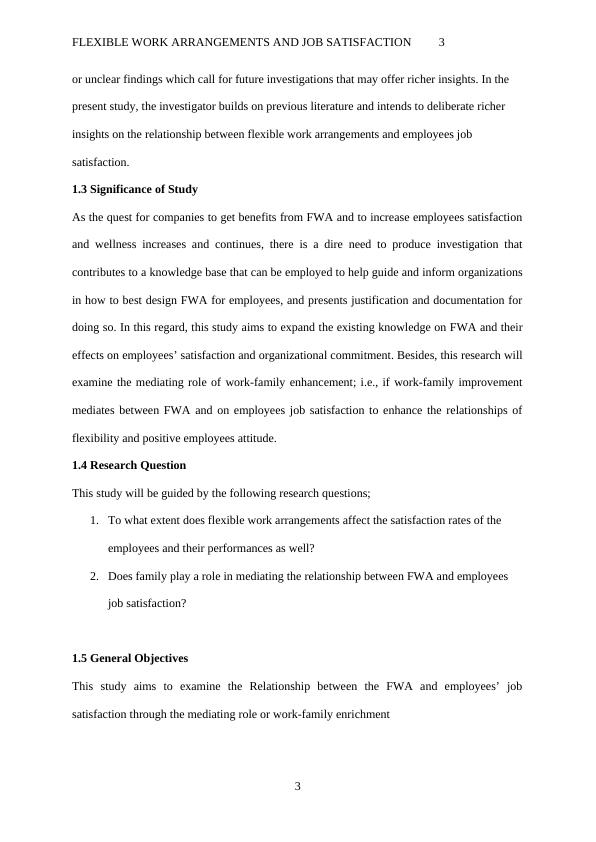
FLEXIBLE WORK ARRANGEMENTS AND JOB SATISFACTION 4
1.5.1 Specific Objectives
Other objectives of this study will include:
To investigate the relationship between the FWA and job satisfaction.
To explore the impact of FWA on organizational performance.
To investigate the mediating role or work-family enrichment in relation to FWA and
employees’ job satisfaction.
1.6 Research Hypothesis
Whereas FWAs have been studied extensively, their relationship with employee satisfaction
has not been explored widely. Nonetheless, the few investigators who have examined the
interdependence between the models exist. For instance, Pedersen and Jeppesen (2012)
established that FWAs impact positively on employee satisfaction and engagement. While
workplace flexibility is a broader model than FWAs (Pettorelli, Else, & Sumner, 2012), it is
possible that FWAs have a positive effect on employees ‘job satisfaction as well. Social
exchange framework (Svensson, 2011) and Signaling theory (Hyatt, & Coslor, 2018) also
propose that this interdependence is feasible. Nonetheless, extant researchers presented that
different types of FWAs might impact employees differently. Consequently, two specific
types of FWAs that will be examined in this paper are flexplace and flextime. Therefore, the
first two hypotheses are:
H1 (Hypothesis 1): The implementation of flexplace positively impacts on employees’ job
satisfaction.
H2 (Hypothesis 2): The implementation of flextime positively impacts on employees’ job
satisfaction.
Furthermore, it is likely that work-to-family enrichment facilitates (mediates) between the
availability of FWAs (telecommuting and flextime) and employees’ job satisfaction levels.
4
1.5.1 Specific Objectives
Other objectives of this study will include:
To investigate the relationship between the FWA and job satisfaction.
To explore the impact of FWA on organizational performance.
To investigate the mediating role or work-family enrichment in relation to FWA and
employees’ job satisfaction.
1.6 Research Hypothesis
Whereas FWAs have been studied extensively, their relationship with employee satisfaction
has not been explored widely. Nonetheless, the few investigators who have examined the
interdependence between the models exist. For instance, Pedersen and Jeppesen (2012)
established that FWAs impact positively on employee satisfaction and engagement. While
workplace flexibility is a broader model than FWAs (Pettorelli, Else, & Sumner, 2012), it is
possible that FWAs have a positive effect on employees ‘job satisfaction as well. Social
exchange framework (Svensson, 2011) and Signaling theory (Hyatt, & Coslor, 2018) also
propose that this interdependence is feasible. Nonetheless, extant researchers presented that
different types of FWAs might impact employees differently. Consequently, two specific
types of FWAs that will be examined in this paper are flexplace and flextime. Therefore, the
first two hypotheses are:
H1 (Hypothesis 1): The implementation of flexplace positively impacts on employees’ job
satisfaction.
H2 (Hypothesis 2): The implementation of flextime positively impacts on employees’ job
satisfaction.
Furthermore, it is likely that work-to-family enrichment facilitates (mediates) between the
availability of FWAs (telecommuting and flextime) and employees’ job satisfaction levels.
4
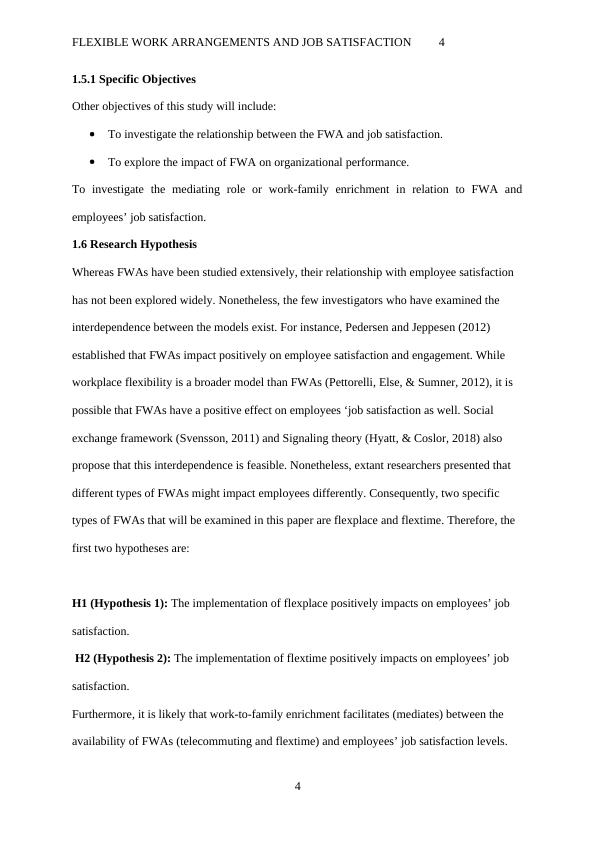
End of preview
Want to access all the pages? Upload your documents or become a member.
Related Documents
Managing International Businesslg...
|69
|20400
|72
Impact of Teamwork Effectiveness on Employee Motivation in Enrichment Centre at Malaysialg...
|90
|34325
|306
IMPACT OF ORGANIZATIONAL CHANGE TOWARDS EMPLOYEE PERFORMANCESlg...
|46
|23346
|300
The Effect of Leadership on Employee Performancelg...
|42
|12225
|21
The Impact of Customer Perceived Value on Customer Satisfaction: A Case Study on MBO Cinemaslg...
|104
|29176
|436
Impacts of Fear of Project Failure on Project Outcomes: Does Leveraging Stress lead to IT Project Success or Failurelg...
|107
|24942
|367
